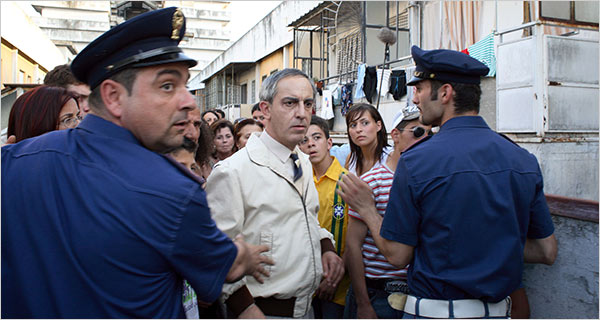Movie review by Greg Carlson
The subtitle of the American market translation of Roberto Saviano’s “Gomorrah” (just “Gomorra” in Italian) reads “a personal journey into the violent international empire of Naples’ organized crime system.” The description accurately explains the young journalist’s inside view of one of the world’s most corrupt regions, which Saviano claims is host to the largest open-air drug market on the planet. While Saviano, one of the movie version’s several credited screenwriters, personalized his written account, filmmaker Matteo Garrone erases all traces of first person subjectivity, opting instead for a sobering documentary style that chronicles the squalor, poverty, and hopelessness of the neighborhoods infected by the warring gangs that define and control essentially every aspect of the local economy.
Saviano’s book strings together a chain of bruising anecdotes illustrating over and over the toll exacted by the criminal enterprise known as the Camorra, a term that probably emerged from the blending of words for “boss” and “gang” that dates to at least the 19th century and which also provides the movie with its punning title. On the page, something is lost in the English translation by Virginia Jewiss, but Saviano’s use of repetition drives home the unyielding totality of the Camorra’s reach. Garrone’s movie version, which is in many ways more austere, heightens the sense of despair, since legitimate businesses don’t even appear to exist and the concrete housing developments of Scampia resemble prison blocks more than places someone would want to call home.
Significantly scaling back the various concerns identified in the book, Garrone weaves together five stories. Skinny thug wannabes Marco (Marco Macor) and Ciro (Ciro Petrone) irk a local mobster by stealing a small arsenal of automatic weapons, including the fearful AK-47 (Saviano devotes an entire chapter to the legendary killing machine, but its impact is only hinted at in the film). Adolescent Toto (Salvatore Abruzzese), a quiet grocery delivery boy, finds the temptations of joining a gang too difficult to resist.
Apprentice Roberto (Carmine Paternoster) learns the ropes of illegal toxic waste dumping from Franco (Toni Servillo). Mid-level courier Don Ciro (Gianfelice Imparato) distributes payouts to families who have experienced death or incarceration as a result of Camorra involvement, and handing out cash proves as dangerous as collecting it. Finally, tailor Pasquale (Salvatore Cantalupo) makes an arrangement to teach his skills to Chinese garment makers in direct competition with the Camorra.
Garrone shuttles among the various story strands, the majority of which result, sooner or later, in outbursts of fierce violence. The director drains the romanticism of Hollywood gangster movies from “Gomorrah,” even though the young men on the screen quote the 1983 version of “Scarface” chapter and verse. Unlike the book, the police and the top level Camorra leadership are figures left unexplored, a choice that will leave some viewers wondering about the extent of corruption and negligence within the Neapolitan legal system. To have included those things would have altered the fabric of the film, and their absence serves as an additional reminder that the poor have few choices outside the Camorra’s vampiric clutches.
